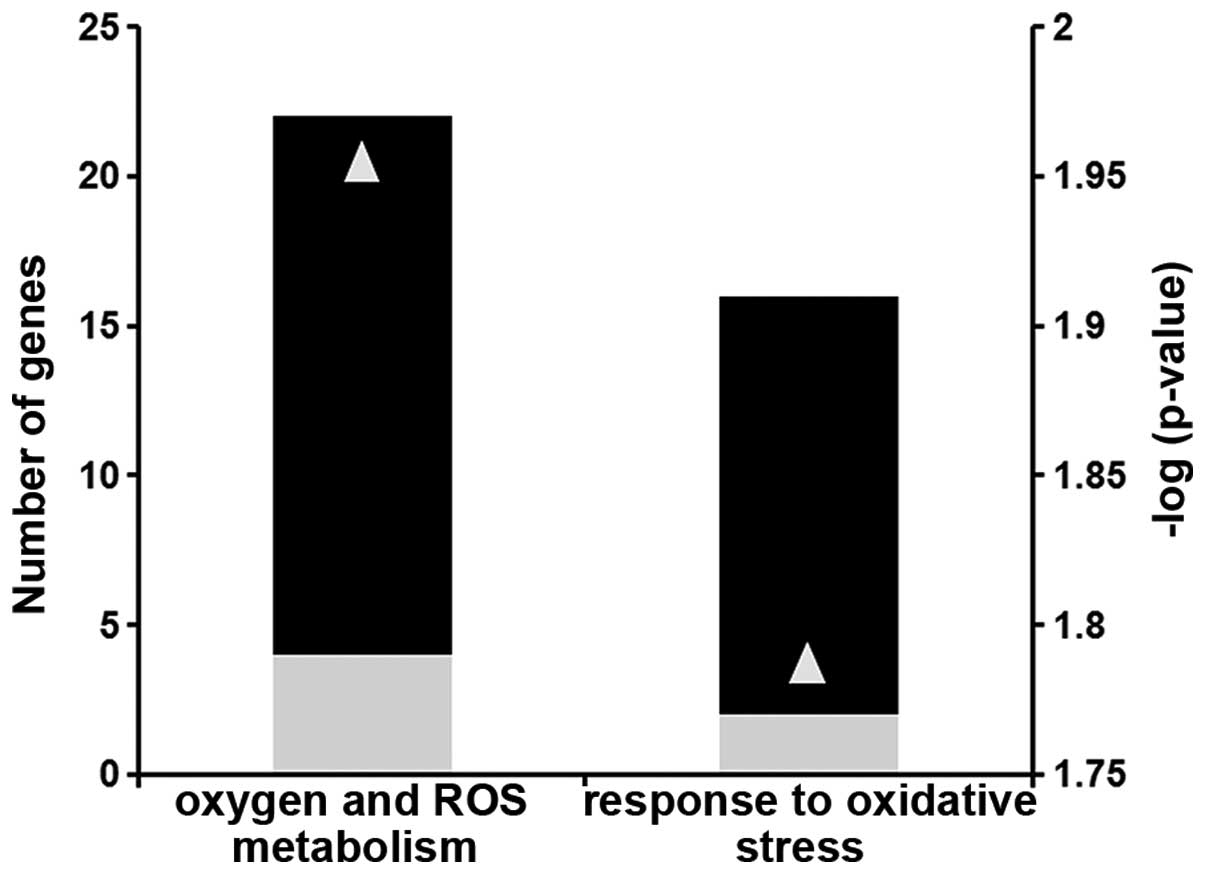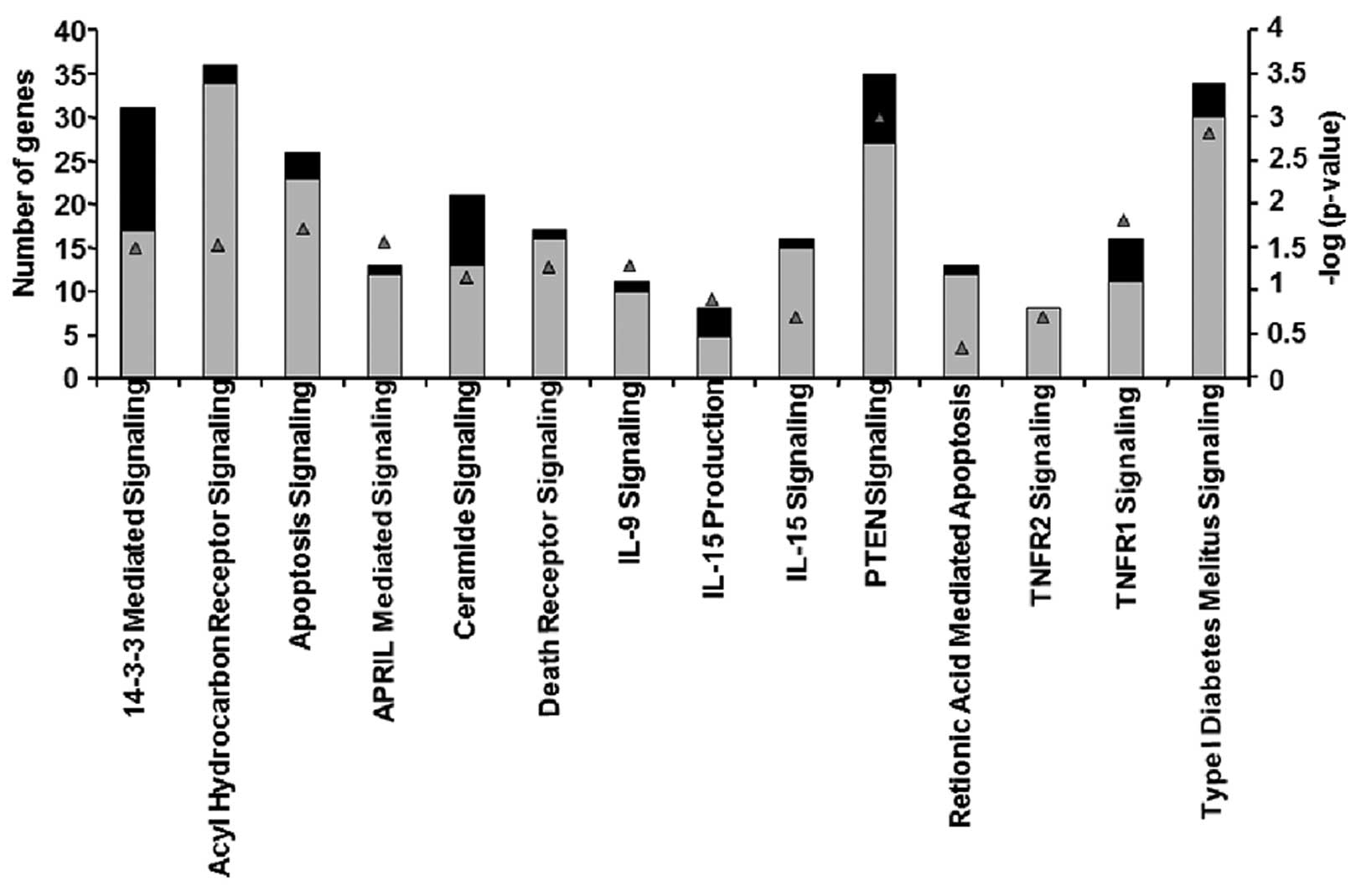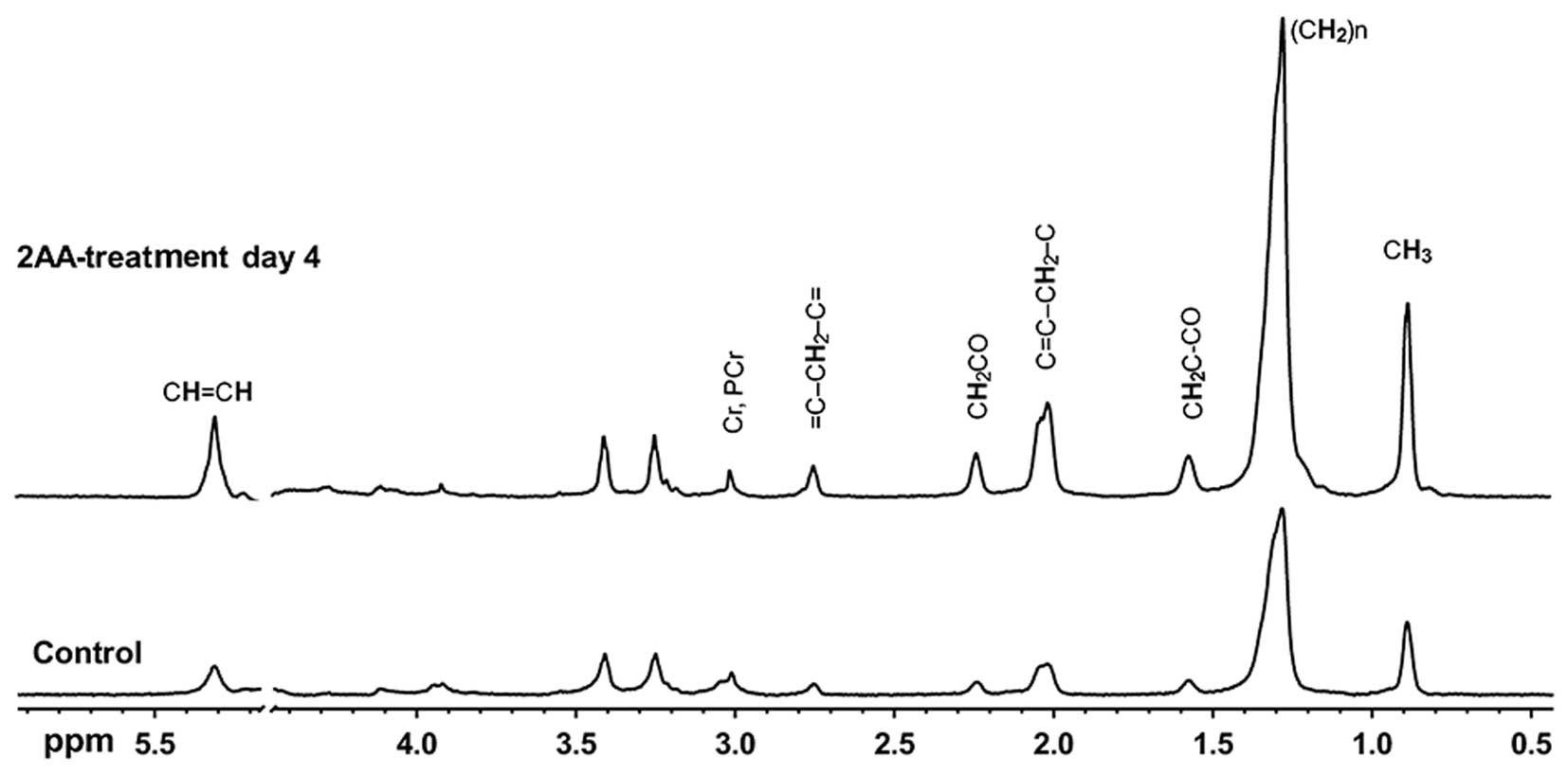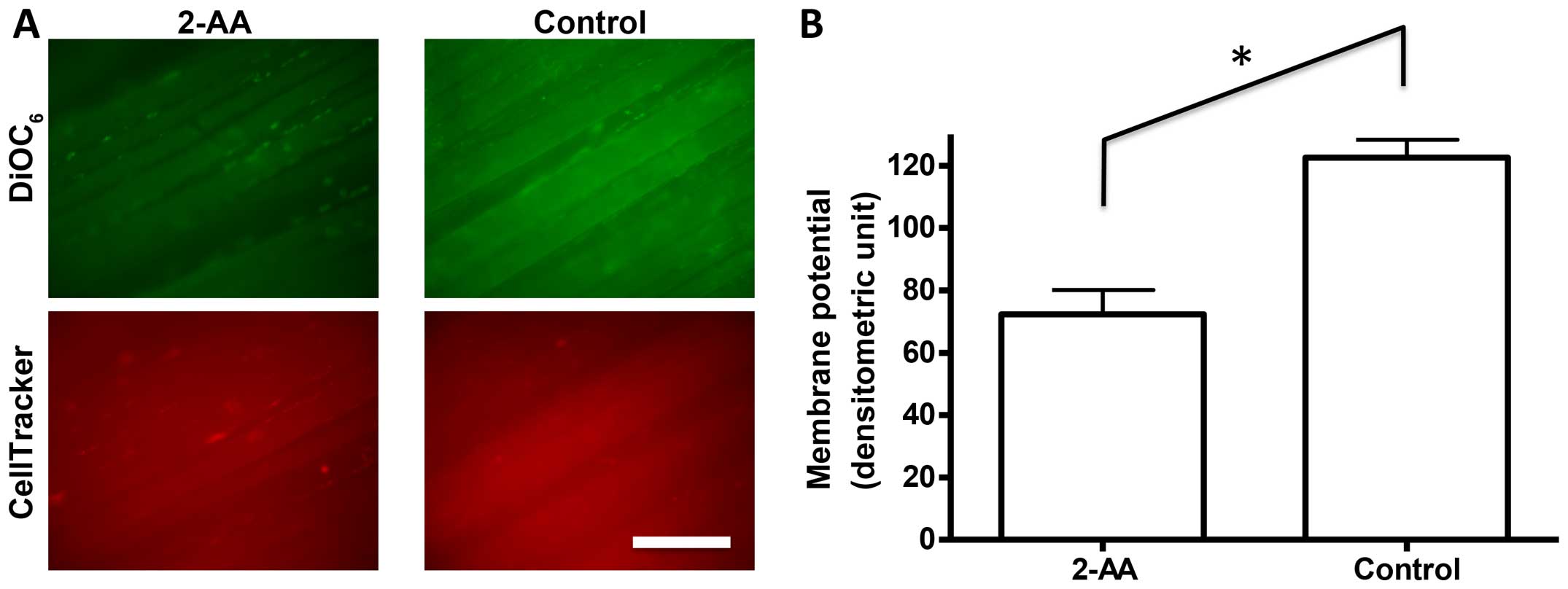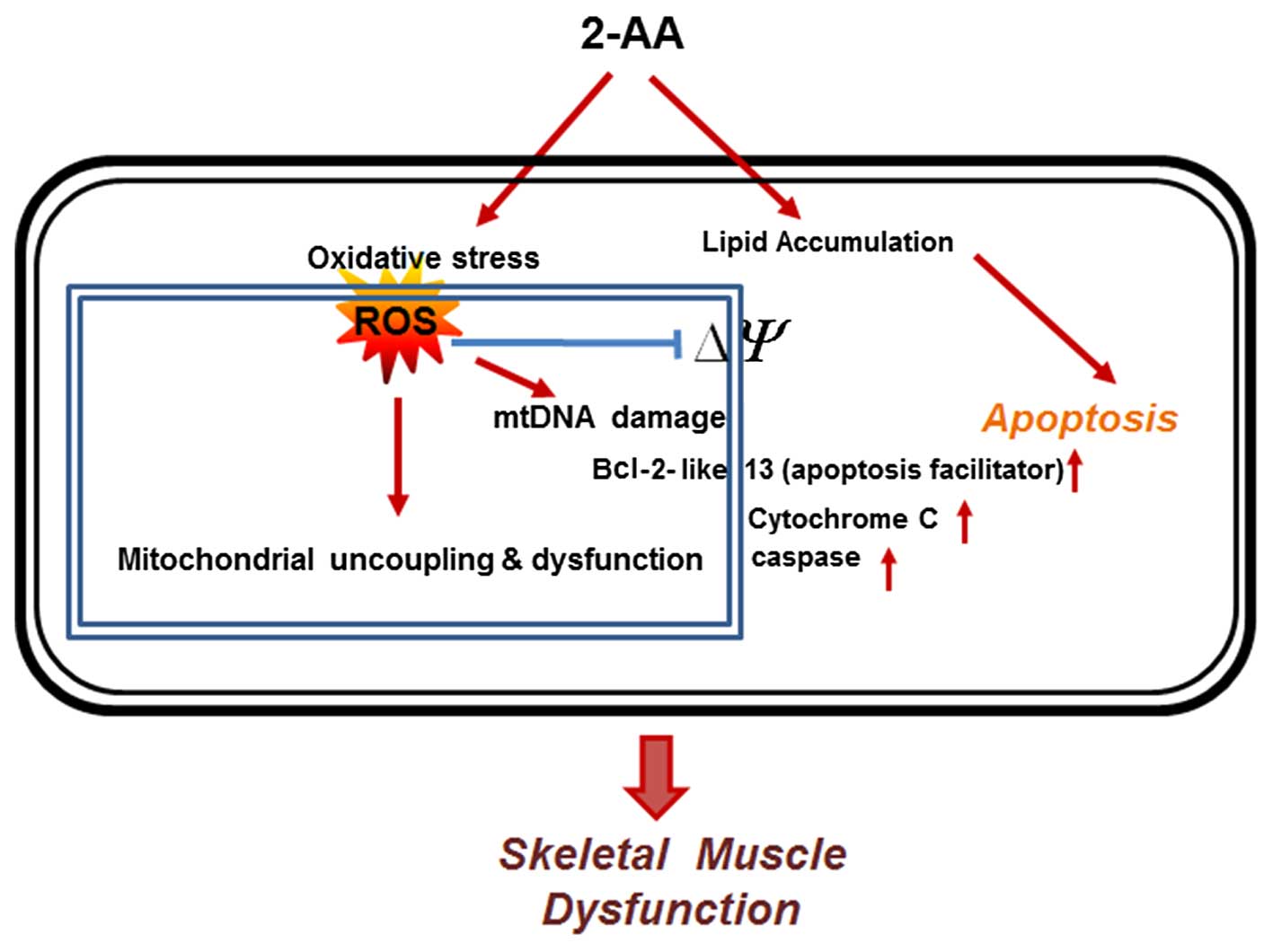|
1
|
Rudel T, Kepp O and Kozjak-Pavlovic V:
Interactions between bacterial pathogens and mitochondrial cell
death pathways. Nat Rev Microbiol. 8:693–705. 2010. View Article : Google Scholar : PubMed/NCBI
|
|
2
|
Jiang JH, Tong J and Gabriel K: Hijacking
mitochondria: bacterial toxins that modulate mitochondrial
function. IUBMB Life. 64:397–401. 2012. View Article : Google Scholar : PubMed/NCBI
|
|
3
|
Trumpower BL: Cytochrome bc1 complexes of
microorganisms. Microbiol Rev. 54:101–129. 1990.PubMed/NCBI
|
|
4
|
Van Ark G and Berden JA: Binding of HQNO
to beef-heart sub-mitochondrial particles. Biochim Biophys Acta.
459:119–127. 1977. View Article : Google Scholar : PubMed/NCBI
|
|
5
|
Schwarzer C, Fu Z, Shuai S, Babbar S, Zhao
G, Li C and Machen TE: Pseudomonas aeruginosa homoserine lactone
triggers apoptosis and Bak/Bax-independent release of mitochondrial
cytochrome C in fibroblasts. Cell Microbiol. 16:1094–1104. 2014.
View Article : Google Scholar : PubMed/NCBI
|
|
6
|
Raza H, John A and Shafarin J: NAC
attenuates LPS-induced toxicity in aspirin-sensitized mouse
macrophages via suppression of oxidative stress and mitochondrial
dysfunction. PLoS One. 9:e1033792014. View Article : Google Scholar : PubMed/NCBI
|
|
7
|
Valyi-Nagy T and Dermody TS: Role of
oxidative damage in the pathogenesis of viral infections of the
nervous system. Histol Histopathol. 20:957–967. 2005.PubMed/NCBI
|
|
8
|
Pohanka M: Role of oxidative stress in
infectious diseases. A review. Folia Microbiol (Praha). 58:503–513.
2013. View Article : Google Scholar
|
|
9
|
Murphy MP: How mitochondria produce
reactive oxygen species. Biochem J. 417:1–13. 2009. View Article : Google Scholar
|
|
10
|
Schieber M and Chandel NS: ROS function in
redox signaling and oxidative stress. Curr Biol. 24:R453–R462.
2014. View Article : Google Scholar : PubMed/NCBI
|
|
11
|
Ding SZ, Minohara Y, Fan XJ, Wang J, Reyes
VE, Patel J, Dirden-Kramer B, Boldogh I, Ernst PB and Crowe SE:
Helicobacter pylori infection induces oxidative stress and
programmed cell death in human gastric epithelial cells. Infect
Immun. 75:4030–4039. 2007. View Article : Google Scholar : PubMed/NCBI
|
|
12
|
Strengert M, Jennings R, Davanture S,
Hayes P, Gabriel G and Knaus UG: Mucosal reactive oxygen species
are required for antiviral response: role of Duox in influenza a
virus infection. Antioxid Redox Signal. 20:2695–2709. 2014.
View Article : Google Scholar
|
|
13
|
Paracha UZ, Fatima K, Alqahtani M,
Chaudhary A, Abuzenadah A, Damanhouri G and Qadri I: Oxidative
stress and hepatitis C virus. Virol J. 10:2512013. View Article : Google Scholar : PubMed/NCBI
|
|
14
|
Pieczenik SR and Neustadt J: Mitochondrial
dysfunction and molecular pathways of disease. Exp Mol Pathol.
83:84–92. 2007. View Article : Google Scholar : PubMed/NCBI
|
|
15
|
Garofalo RP, Kolli D and Casola A:
Respiratory syncytial virus infection: mechanisms of redox control
and novel therapeutic opportunities. Antioxid Redox Signal.
18:186–217. 2013. View Article : Google Scholar :
|
|
16
|
Ashida H, Mimuro H, Ogawa M, Kobayashi T,
Sanada T, Kim M and Sasakawa C: Cell death and infection: a
double-edged sword for host and pathogen survival. J Cell Biol.
195:931–942. 2011. View Article : Google Scholar : PubMed/NCBI
|
|
17
|
Guicciardi ME and Gores GJ: Life and death
by death receptors. FASEB J. 23:1625–1637. 2009. View Article : Google Scholar : PubMed/NCBI
|
|
18
|
Madeo F, Carmona-Gutierrez D, Ring J,
Büttner S, Eisenberg T and Kroemer G: Caspase-dependent and
caspase-independent cell death pathways in yeast. Biochem Biophys
Res Commun. 382:227–231. 2009. View Article : Google Scholar : PubMed/NCBI
|
|
19
|
Galli F, Battistoni A, Gambari R, Pompella
A, Bragonzi A, Pilolli F, Iuliano L, Piroddi M, Dechecchi MC and
Cabrini G: Working Group on Inflammation in Cystic Fibrosis:
oxidative stress and antioxidant therapy in cystic fibrosis.
Biochim Biophys Acta. 1822:690–713. 2012. View Article : Google Scholar : PubMed/NCBI
|
|
20
|
Navon-Venezia S, Ben-Ami R and Carmeli Y:
Update on Pseudomonas aeruginosa and Acinetobacter baumannii
infections in the healthcare setting. Curr Opin Infect Dis.
18:306–313. 2005. View Article : Google Scholar : PubMed/NCBI
|
|
21
|
Kerr KG and Snelling AM: Pseudomonas
aeruginosa: a formidable and ever-present adversary. J Hosp Infect.
73:338–344. 2009. View Article : Google Scholar : PubMed/NCBI
|
|
22
|
Jimenez PN, Koch G, Thompson JA, Xavier
KB, Cool RH and Quax WJ: The multiple signaling systems regulating
virulence in Pseudomonas aeruginosa. Microbiol Mol Biol Rev.
76:46–65. 2012. View Article : Google Scholar : PubMed/NCBI
|
|
23
|
Déziel E, Gopalan S, Tampakaki AP, Lépine
F, Padfield KE, Saucier M, Xiao G and Rahme LG: The contribution of
MvfR to Pseudomonas aeruginosa pathogenesis and quorum sensing
circuitry regulation: multiple quorum sensing-regulated genes are
modulated without affecting lasRI, rhlRI or the production of
N-acyl-L-homoserine lactones. Mol Microbiol. 55:998–1014. 2005.
View Article : Google Scholar : PubMed/NCBI
|
|
24
|
Xiao G, Déziel E, He J, Lépine F, Lesic B,
Castonguay MH, Milot S, Tampakaki AP, Stachel SE and Rahme LG:
MvfR, a key Pseudomonas aeruginosa pathogenicity LTTR-class
regulatory protein, has dual ligands. Mol Microbiol. 62:1689–1699.
2006. View Article : Google Scholar : PubMed/NCBI
|
|
25
|
Parker CT and Sperandio V: Cell-to-cell
signalling during pathogenesis. Cell Microbiol. 11:363–369. 2009.
View Article : Google Scholar :
|
|
26
|
Kesarwani M, Hazan R, He J, Que YA,
Apidianakis Y, Lesic B, Xiao G, Dekimpe V, Milot S, Deziel E, et
al: A quorum sensing regulated small volatile molecule reduces
acute virulence and promotes chronic infection phenotypes. PLoS
Pathog. 7:e10021922011. View Article : Google Scholar : PubMed/NCBI
|
|
27
|
Zhou L, Slamti L, Nielsen-LeRoux C,
Lereclus D and Raymond B: The social biology of quorum sensing in a
naturalistic host pathogen system. Curr Biol. 24:2417–2422. 2014.
View Article : Google Scholar : PubMed/NCBI
|
|
28
|
Ng WL and Bassler BL: Bacterial
quorum-sensing network architectures. Annu Rev Genet. 43:197–222.
2009. View Article : Google Scholar : PubMed/NCBI
|
|
29
|
Rumbaugh KP and Kaufmann GF: Exploitation
of host signaling pathways by microbial quorum sensing signals.
Curr Opin Microbiol. 15:162–168. 2012. View Article : Google Scholar
|
|
30
|
Bandyopadhaya A, Kesarwani M, Que YA, He
J, Padfield K, Tompkins R and Rahme LG: The quorum sensing volatile
molecule 2-amino acetophenon modulates host immune responses in a
manner that promotes life with unwanted guests. PLoS Pathog.
8:e10030242012. View Article : Google Scholar : PubMed/NCBI
|
|
31
|
Que YA, Hazan R, Strobel B, Maura D, He J,
Kesarwani M, Panopoulos P, Tsurumi A, Giddey M, Wilhelmy J, et al:
A quorum sensing small volatile molecule promotes antibiotic
tolerance in bacteria. PLoS One. 8:e801402013. View Article : Google Scholar : PubMed/NCBI
|
|
32
|
Tzika AA, Constantinou C, Bandyopadhaya A,
Psychogios N, Lee S, Mindrinos M, Martyn JA, Tompkins RG and Rahme
LG: A small volatile bacterial molecule triggers mitochondrial
dysfunction in murine skeletal muscle. PLoS One. 8:e745282013.
View Article : Google Scholar : PubMed/NCBI
|
|
33
|
Astrakas LG, Goljer I, Yasuhara S,
Padfield KE, Zhang Q, Gopalan S, Mindrinos MN, Dai G, Yu YM, Martyn
JA, et al: Proton NMR spectroscopy shows lipids accumulate in
skeletal muscle in response to burn trauma-induced apoptosis. FASEB
J. 19:1431–1440. 2005. View Article : Google Scholar : PubMed/NCBI
|
|
34
|
Padfield KE, Astrakas LG, Zhang Q, Gopalan
S, Dai G, Mindrinos MN, Tompkins RG, Rahme LG and Tzika AA: Burn
injury causes mitochondrial dysfunction in skeletal muscle. Proc
Natl Acad Sci USA. 102:5368–5373. 2005. View Article : Google Scholar : PubMed/NCBI
|
|
35
|
Morvan D, Demidem A, Papon J and Madelmont
JC: Quantitative HRMAS proton total correlation spectroscopy
applied to cultured melanoma cells treated by chloroethyl
nitrosourea: demonstration of phospholipid metabolism alterations.
Magn Reson Med. 49:241–248. 2003. View Article : Google Scholar : PubMed/NCBI
|
|
36
|
Asai A, Sahani N, Kaneki M, Ouchi Y,
Martyn JA and Yasuhara SE: Primary role of functional ischemia,
quantitative evidence for the two-hit mechanism, and
phosphodiesterase-5 inhibitor therapy in mouse muscular dystrophy.
PLoS One. 2:e8062007. View Article : Google Scholar : PubMed/NCBI
|
|
37
|
Hosokawa S, Koseki H, Nagashima M, Maeyama
Y, Yomogida K, Mehr C, Rutledge M, Greenfeld H, Kaneki M, Tompkins
RG, et al: Title efficacy of phosphodiesterase 5 inhibitor on
distant burn-induced muscle autophagy, microcirculation, and
survival rate. Am J Physiol Endocrinol Metab. 304:E922–E933. 2013.
View Article : Google Scholar : PubMed/NCBI
|
|
38
|
Burgmaier G, Schönrock LM, Kuhlmann T,
Richter-Landsberg C and Brück W: Association of increased bcl-2
expression with rescue from tumor necrosis factor-alpha-induced
cell death in the oligodendrocyte cell line OLN-93. J Neurochem.
75:2270–2276. 2000. View Article : Google Scholar : PubMed/NCBI
|
|
39
|
Tzifi F, Economopoulou C, Gourgiotis D,
Ardavanis A, Papageorgiou S and Scorilas A: The role of BCL2 family
of apoptosis regulator proteins in acute and chronic leukemias. Adv
Hematol. 2012:5243082012. View Article : Google Scholar
|
|
40
|
Davies L, Spiller D, White MR, Grierson I
and Paraoan L: PERP expression stabilizes active p53 via modulation
of p53-MDM2 interaction in uveal melanoma cells. Cell Death Dis.
2:e1362011. View Article : Google Scholar : PubMed/NCBI
|
|
41
|
Huo J, Xu S and Lam KP: Fas apoptosis
inhibitory molecule regulates T cell receptor-mediated apoptosis of
thymocytes by modulating Akt activation and Nur77 expression. J
Biol Chem. 285:11827–11835. 2010. View Article : Google Scholar : PubMed/NCBI
|
|
42
|
Zhou H, Ge Y, Sun L, Ma W, Wu J, Zhang X,
Hu X, Eaves CJ, Wu D and Zhao Y: Growth arrest specific 2 is
up-regulated in chronic myeloid leukemia cells and required for
their growth. PLoS One. 9:e861952014. View Article : Google Scholar : PubMed/NCBI
|
|
43
|
Tzika AA, Astrakas LG, Cao H, Mintzopoulos
D, Zhang Q, Padfield K, Yu H, Mindrinos MN, Rahme LG and Tompkins
RG: Murine intramyocellular lipids quantified by NMR act as
metabolic biomarkers in burn trauma. Int J Mol Med. 21:825–832.
2008.PubMed/NCBI
|
|
44
|
Yuzefovych LV, Musiyenko SI, Wilson GL and
Rachek LI: Mitochondrial DNA damage and dysfunction, and oxidative
stress are associated with endoplasmic reticulum stress, protein
degradation and apoptosis in high fat diet-induced insulin
resistance mice. PLoS One. 8:e540592013. View Article : Google Scholar : PubMed/NCBI
|
|
45
|
Blankenberg FG: In vivo detection of
apoptosis. J Nucl Med. 49(Suppl 2): 81S–95S. 2008. View Article : Google Scholar : PubMed/NCBI
|
|
46
|
Vayssier-Taussat M, Kreps SE, Adrie C,
Dall'Ava J, Christiani D and Polla BS: Mitochondrial membrane
potential: a novel biomarker of oxidative environmental stress.
Environ Health Perspect. 110:301–305. 2002. View Article : Google Scholar : PubMed/NCBI
|
|
47
|
Marchi S, Giorgi C, Suski JM, Agnoletto C,
Bononi A, Bonora M, De Marchi E, Missiroli S, Patergnani S, Poletti
F, et al: Mitochondria-ros crosstalk in the control of cell death
and aging. J Signal Transduct. 2012:3296352012. View Article : Google Scholar
|
|
48
|
Shokolenko I, Venediktova N, Bochkareva A,
Wilson GL and Alexeyev MF: Oxidative stress induces degradation of
mitochondrial DNA. Nucleic Acids Res. 37:2539–2548. 2009.
View Article : Google Scholar : PubMed/NCBI
|
|
49
|
Blasiak J, Glowacki S, Kauppinen A and
Kaarniranta K: Mitochondrial and nuclear DNA damage and repair in
age-related macular degeneration. Int J Mol Sci. 14:2996–3010.
2013. View Article : Google Scholar : PubMed/NCBI
|
|
50
|
Handschin C and Spiegelman BM: Peroxisome
proliferator-activated receptor gamma coactivator 1 coactivators,
energy homeostasis, and metabolism. Endocr Rev. 27:728–735. 2006.
View Article : Google Scholar : PubMed/NCBI
|
|
51
|
Lin J, Handschin C and Spiegelman BM:
Metabolic control through the PGC-1 family of transcription
coactivators. Cell Metab. 1:361–370. 2005. View Article : Google Scholar : PubMed/NCBI
|
|
52
|
Supinski GS and Callahan LA: Caspase
activation contributes to endotoxin-induced diaphragm weakness. J
Appl Physiol (1985). 100:1770–1777. 2006. View Article : Google Scholar
|
|
53
|
Tatsumi T, Shiraishi J, Keira N, Akashi K,
Mano A, Yamanaka S, Matoba S, Fushiki S, Fliss H and Nakagawa M:
Intracellular ATP is required for mitochondrial apoptotic pathways
in isolated hypoxic rat cardiac myocytes. Cardiovasc Res.
59:428–440. 2003. View Article : Google Scholar : PubMed/NCBI
|
|
54
|
Danial NN and Korsmeyer SJ: Cell death:
critical control points. Cell. 116:205–219. 2004. View Article : Google Scholar : PubMed/NCBI
|
|
55
|
Szczepaniak LS, Babcock EE, Schick F,
Dobbins RL, Garg A, Burns DK, McGarry JD and Stein DT: Measurement
of intracellular triglyceride stores by H spectroscopy: validation
in vivo. Am J Physiol. 276:E977–E989. 1999.PubMed/NCBI
|
|
56
|
Petersen KF, Befroy D, Dufour S, Dziura J,
Ariyan C, Rothman DL, DiPietro L, Cline GW and Shulman GI:
Mitochondrial dysfunction in the elderly: possible role in insulin
resistance. Science. 300:1140–1142. 2003. View Article : Google Scholar : PubMed/NCBI
|
|
57
|
Petersen KF, Dufour S, Befroy D, Garcia R
and Shulman GI: Impaired mitochondrial activity in the
insulin-resistant offspring of patients with type 2 diabetes. N
Engl J Med. 350:664–671. 2004. View Article : Google Scholar : PubMed/NCBI
|
|
58
|
Blankenberg FG, Katsikis PD, Storrs RW,
Beaulieu C, Spielman D, Chen JY, Naumovski L and Tait JF:
Quantitative analysis of apoptotic cell death using proton nuclear
magnetic resonance spectroscopy. Blood. 89:3778–3786.
1997.PubMed/NCBI
|
|
59
|
Boren J and Brindle KM: Apoptosis-induced
mitochondrial dysfunction causes cytoplasmic lipid droplet
formation. Cell Death Differ. 19:1561–1570. 2012. View Article : Google Scholar : PubMed/NCBI
|
|
60
|
Hakumäki JM, Poptani H, Sandmair AM,
Ylä-Herttuala S and Kauppinen RA: 1H MRS detects
polyunsaturated fatty acid accumulation during gene therapy of
glioma: implications for the in vivo detection of apoptosis. Nat
Med. 5:1323–1327. 1999. View
Article : Google Scholar
|
|
61
|
Mullen TD and Obeid LM: Ceramide and
apoptosis: Exploring the enigmatic connections between sphingolipid
metabolism and programmed cell death. Anticancer Agents Med Chem.
12:340–363. 2012. View Article : Google Scholar
|
|
62
|
Martinez TN, Chen X, Bandyopadhyay S,
Merrill AH and Tansey MG: Ceramide sphingolipid signaling mediates
Tumor Necrosis Factor (TNF)-dependent toxicity via caspase
signaling in dopaminergic neurons. Mol Neurodegener. 7:452012.
View Article : Google Scholar : PubMed/NCBI
|
|
63
|
Giussani P, Tringali C, Riboni L, Viani P
and Venerando B: Sphingolipids: key regulators of apoptosis and
pivotal players in cancer drug resistance. Int J Mol Sci.
15:4356–4392. 2014. View Article : Google Scholar : PubMed/NCBI
|
|
64
|
Aureli M, Murdica V, Loberto N, Samarani
M, Prinetti A, Bassi R and Sonnino S: Exploring the link between
ceramide and ionizing radiation. Glycoconj J. 31:449–459. 2014.
View Article : Google Scholar : PubMed/NCBI
|
|
65
|
Jenkins GM: The emerging role for
sphingolipids in the eukaryotic heat shock response. Cell Mol Life
Sci. 60:701–710. 2003. View Article : Google Scholar : PubMed/NCBI
|
|
66
|
Van Brocklyn JR and Williams JB: The
control of the balance between ceramide and sphingosine-1-phosphate
by sphingosine kinase: oxidative stress and the seesaw of cell
survival and death. Comp Biochem Physiol B Biochem Mol Biol.
163:26–36. 2012. View Article : Google Scholar : PubMed/NCBI
|
|
67
|
Yasuhara S, Asai A, Sahani ND and Martyn
JA: Mitochondria, endoplasmic reticulum, and alternative pathways
of cell death in critical illness. Crit Care Med. 35(Suppl):
S488–S495. 2007. View Article : Google Scholar : PubMed/NCBI
|
|
68
|
Bernardi P and Di Lisa F: The
mitochondrial permeability transition pore: molecular nature and
role as a target in cardioprotection. J Mol Cell Cardiol.
78:100–106. 2015. View Article : Google Scholar :
|
|
69
|
Nabben M, Shabalina IG, Moonen-Kornips E,
van Beurden D, Cannon B, Schrauwen P, Nedergaard J and Hoeks J:
Uncoupled respiration, ROS production, acute lipotoxicity and
oxidative damage in isolated skeletal muscle mitochondria from
UCP3-ablated mice. Biochim Biophys Acta. 1807:1095–1105. 2011.
View Article : Google Scholar : PubMed/NCBI
|
|
70
|
Reynolds HY, Di Sant'Agnese PA and Zierdt
CH: Mucoid Pseudomonas aeruginosa. A sign of cystic fibrosis in
young adults with chronic pulmonary disease? JAMA. 236:2190–2192.
1976. View Article : Google Scholar : PubMed/NCBI
|
|
71
|
Scott-Thomas AJ, Syhre M, Pattemore PK,
Epton M, Laing R, Pearson J and Chambers ST: 2-Aminoacetophenone as
a potential breath biomarker for Pseudomonas aeruginosa in the
cystic fibrosis lung. BMC Pulm Med. 10:562010. View Article : Google Scholar : PubMed/NCBI
|
|
72
|
Velsor LW, Kariya C, Kachadourian R and
Day BJ: Mitochondrial oxidative stress in the lungs of cystic
fibrosis transmembrane conductance regulator protein mutant mice.
Am J Respir Cell Mol Biol. 35:579–586. 2006. View Article : Google Scholar : PubMed/NCBI
|
|
73
|
Divangahi M, Balghi H, Danialou G, Comtois
AS, Demoule A, Ernest S, Haston C, Robert R, Hanrahan JW, Radzioch
D and Petrof BJ: Lack of CFTR in skeletal muscle predisposes to
muscle wasting and diaphragm muscle pump failure in cystic fibrosis
mice. PLoS Genet. 5:e10005862009. View Article : Google Scholar : PubMed/NCBI
|
|
74
|
Rottner M, Tual-Chalot S, Mostefai HA,
Andriantsitohaina R, Freyssinet JM and Martínez MC: Increased
oxidative stress induces apoptosis in human cystic fibrosis cells.
PLoS One. 6:e248802011. View Article : Google Scholar : PubMed/NCBI
|
|
75
|
Moylan JS and Reid MB: Oxidative stress,
chronic disease, and muscle wasting. Muscle Nerve. 35:411–429.
2007. View Article : Google Scholar : PubMed/NCBI
|
|
76
|
Schwartz LM: Atrophy and programmed cell
death of skeletal muscle. Cell Death Differ. 15:1163–1169. 2008.
View Article : Google Scholar : PubMed/NCBI
|
|
77
|
Aare S, Radell P, Eriksson LI, Akkad H,
Chen YW, Hoffman EP and Larsson L: Effects of corticosteroids in
the development of limb muscle weakness in a porcine intensive care
unit model. Physiol Genomics. 45:312–320. 2013. View Article : Google Scholar : PubMed/NCBI
|
|
78
|
Xu H, Lam SH, Shen Y and Gong Z:
Genome-wide identification of molecular pathways and biomarkers in
response to arsenic exposure in zebrafish liver. PLoS One.
8:e687372013. View Article : Google Scholar : PubMed/NCBI
|
|
79
|
Maestre I, Jordán J, Calvo S, Reig JA,
Ceña V, Soria B, Prentki M and Roche E: Mitochondrial dysfunction
is involved in apoptosis induced by serum withdrawal and fatty
acids in the beta-cell line INS-1. Endocrinology. 144:335–345.
2003. View Article : Google Scholar
|
|
80
|
Lartigue L and Faustin B: Mitochondria:
metabolic regulators of innate immune responses to pathogens and
cell stress. Int J Biochem Cell Biol. 45:2052–2056. 2013.
View Article : Google Scholar : PubMed/NCBI
|
|
81
|
Nicolson GL: Mitochondrial dysfunction and
chronic disease: treatment with natural supplements. Altern Ther
Health Med. at50272013.PubMed/NCBI
|
|
82
|
Frick CG, Fink H, Gordan ML, Eckel B,
Martyn JA and Blobner M: Chronic Escherichia coli infection induces
muscle wasting without changing acetylcholine receptor numbers.
Intensive Care Med. 34:561–567. 2008. View Article : Google Scholar
|
|
83
|
Macallan DC, McNurlan MA, Kurpad AV, de
Souza G, Shetty PS, Calder AG and Griffin GE: Whole body protein
metabolism in human pulmonary tuberculosis and undernutrition:
evidence for anabolic block in tuberculosis. Clin Sci (Lond).
94:321–331. 1998. View Article : Google Scholar
|
|
84
|
Machado AM, Desler C, Bøggild S,
Strickertsson JA, Friis-Hansen L, Figueiredo C, Seruca R and
Rasmussen LJ: Helicobacter pylori infection affects mitochondrial
function and DNA repair, thus, mediating genetic instability in
gastric cells. Mech Ageing Dev. 134:460–466. 2013. View Article : Google Scholar : PubMed/NCBI
|
|
85
|
Morton RE, Hutchings J, Halliday D, Rennie
MJ and Wolman SL: Protein metabolism during treatment of chest
infection in patients with cystic fibrosis. Am J Clin Nutr.
47:214–219. 1988.PubMed/NCBI
|















